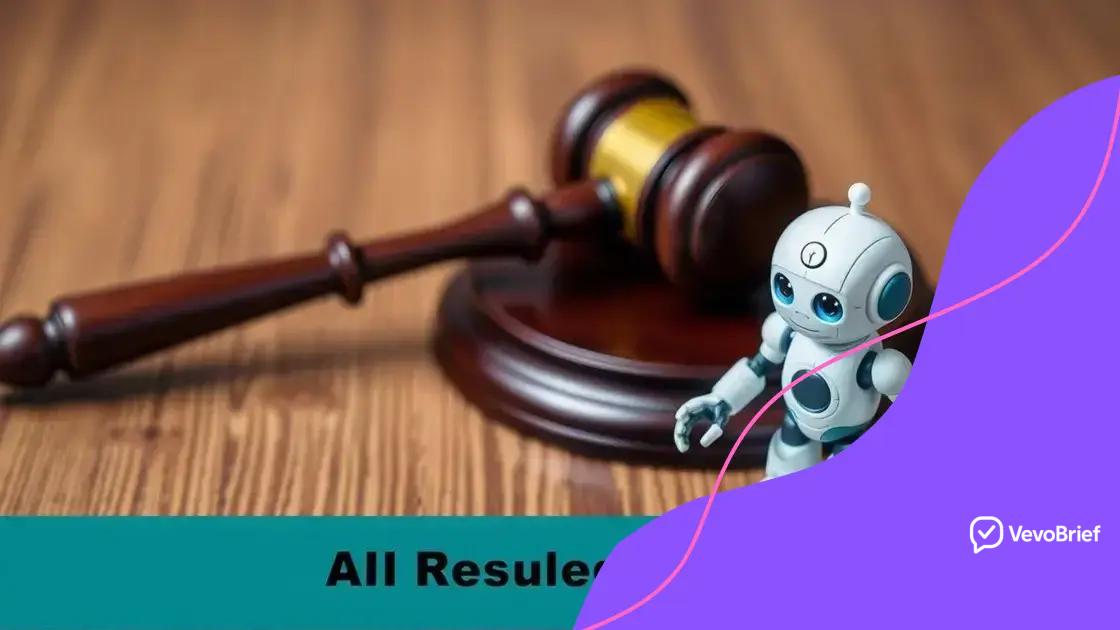Legal challenges to AI regulation: what you need to know

Legal challenges to AI regulation are ongoing, impacting innovation, compliance, and stakeholders, with significant implications for ethical standards and technological advancement in the AI landscape.
Legal challenges to AI regulation are an ongoing topic that affects technology and society. With rapid advancements in AI, questions around ethics, accountability, and compliance are more relevant than ever. Have you thought about how these legal battles impact the technology you use daily?
Understanding the current AI regulatory landscape
Understanding the current AI regulatory landscape is vital for anyone interested in technology today. With the rapid development of artificial intelligence, regulations are struggling to keep pace. This challenge has brought attention to the need for robust guidelines.
Key Aspects of AI Regulation
Regulatory bodies worldwide are focusing on various aspects of AI. Here are some critical elements they address:
- Accountability: It is crucial to determine who is responsible when AI systems fail or cause harm.
- Data Privacy: AI systems often rely on large amounts of data, creating concerns around user privacy and data protection.
- Transparency: Ensuring that AI systems operate in an understandable manner is key to building public trust.
- Ethics: Ethical considerations are essential to guide the development of responsible AI systems.
The challenge of balancing innovation and regulation leads to ongoing discussions among lawmakers, technologists, and ethicists. As new technologies emerge, so do the questions surrounding their use. Striking a balance is no easy feat, as regulations must foster innovation while protecting society.
The Global Perspective
Countries around the globe are exploring their approaches to AI regulation. Different regions have unique concerns based on their social and cultural contexts. For instance, in Europe, there is a strong emphasis on data protection, while the United States focuses more on innovation and competition. These varying strategies highlight the need for international dialogue and collaboration.
As discussions progress, the regulatory landscape for AI is likely to become more complex. Stakeholders from various sectors must engage in these discussions to ensure that regulations benefit everyone while avoiding stifling creativity.
In summary, the current AI regulatory landscape is a dynamic and multifaceted subject. Understanding the interplay between technology development and regulation is essential for navigating the future of AI.
Key legal cases shaping AI regulation
Key legal cases are pivotal in shaping AI regulation today. These cases not only influence laws but also highlight the challenges and responsibilities associated with AI technologies. Some landmark decisions are setting important precedents.
Notable Legal Cases
Several cases have emerged as significant in the realm of AI regulation. Here are a few that stand out:
- The Case of GPT-3 Use: This case revolves around copyright issues regarding the outputs generated by AI systems like GPT-3. The decision may affect how AI-generated content is treated under existing laws.
- Facial Recognition Lawsuit: A lawsuit against a tech company over the misuse of facial recognition technology raised concerns about privacy, bias, and discrimination.
- Employment Discrimination Cases: Cases involving AI in hiring processes highlight the need for regulations that prevent discrimination and ensure fairness.
- Data Breach Litigation: Lawsuits related to data breaches involving AI systems underline the importance of data security and transparent practices.
As these cases unfold, they bring to light the evolving nature of regulations in this area. Operators of AI systems are urged to stay informed about these proceedings, as outcomes can directly impact their practices. Legal precedents are being established that will govern the future of artificial intelligence technologies, making it crucial for stakeholders to pay attention.
The Implications of Legal Outcomes
Legal outcomes from these cases can significantly influence the direction of AI regulations. A ruling could set a standard that impacts not only individual companies but also entire industries. For instance, a favorable ruling for AI-generated content might encourage more innovation, while unfavorable outcomes could lead to stricter regulations that stifle creativity.
In addition, the responses from other countries towards these cases will be important. Countries observing these legal developments may adapt their own laws accordingly, resulting in a more unified regulatory approach or, conversely, a divergence in international standards.
Implications of AI regulation on innovation

Implications of AI regulation on innovation are profound and multifaceted. While regulations aim to protect users and promote ethical standards, they can also shape the landscape of technological advancements.
Balancing Safety and Creativity
Regulation serves to ensure that AI development occurs in a safe environment. However, overly stringent measures may deter innovation. Companies may hesitate to invest in new technologies if they fear excessive restrictions. Striking this balance is crucial for a thriving tech ecosystem.
- Encouraging Responsible Innovation: Regulations can foster a culture of accountability, where companies prioritize ethical considerations in their projects.
- Investment Dynamics: Clear guidelines can boost investor confidence, knowing that there is a framework to support sustainable AI growth.
- Global Competitiveness: Countries with balanced regulations may lead in AI advancements, attracting talent and resources.
Freezing innovation can result from inconsistent or unclear regulations. Companies may find themselves navigating a maze of rules that vary by location. This unpredictability can harm not only the industry but also society’s access to innovative solutions that AI can provide.
Innovation Hurdles
While regulations can uplift certain areas of AI, they can also present significant hurdles. By imposing complex compliance requirements, regulators could unintentionally stifle smaller startups that lack the resources to meet these demands. This could lead to a landscape dominated by larger firms, reducing diversity in innovative solutions.
Furthermore, regulation must adapt as technology evolves. The rapid pace of AI development means that legal frameworks can quickly become outdated. Keeping up with technological changes is essential to ensure that regulations do not hinder progress.
In summary, the relationship between AI regulation and innovation is complex. Regulations must be designed thoughtfully to promote both safety and creativity, allowing for the responsible growth of this transformative technology.
Stakeholders in the AI regulation debate
Stakeholders in the AI regulation debate play critical roles in shaping the future of artificial intelligence. Different parties have diverse interests and concerns that contribute to the complex discussion surrounding AI governance.
Key Stakeholders
Some of the main stakeholders include:
- Tech Companies: Major tech firms are at the forefront of AI development. They often push for regulations that support innovation while addressing safety and ethical issues.
- Government Regulators: Government bodies seek to protect the public from misuse of AI technologies. They aim to create frameworks that balance innovation with safety.
- Consumers: As users of AI technology, consumers are concerned about privacy, security, and ethical implications. Their interests should be a primary consideration in regulation.
- Academics and Researchers: These stakeholders study the implications of AI and contribute to the dialogue by providing data and insights. They help shape policies that impact the field.
- Advocacy Groups: Various advocacy organizations focus on issues like data privacy, human rights, and ethical use of technology. Their perspectives are essential in influencing regulatory decisions.
The discussions among these stakeholders are often intense. For instance, tech companies may argue for fewer regulations to foster creativity, while consumer groups may advocate for stricter measures to ensure safety and privacy. These varied interests sometimes lead to conflicts, requiring careful negotiation and dialogue.
Finding Common Ground
To effectively navigate the regulatory landscape, stakeholders must find common ground. This involves understanding each other’s perspectives and working collaboratively towards solutions that address concerns across the board. Open forums and public consultations can facilitate this dialogue, allowing for a more inclusive approach to AI regulation.
The ongoing development of AI technology requires continuous engagement among stakeholders to adapt regulations as needed. Through collaboration, a cohesive framework can emerge that supports innovation while prioritizing public interest.
Future trends in AI compliance and law
Future trends in AI compliance and law are essential to understand, as they will shape how technology is developed and used. As AI continues to evolve, so do the legal frameworks surrounding it. Keeping pace with these changes is vital for businesses and lawmakers alike.
Emerging Compliance Standards
New compliance standards are expected to emerge as governments recognize the need for effective regulation. These standards will likely focus on:
- Data Protection: Enhanced rules to safeguard personal data are anticipated, especially as data breaches become more common.
- Transparency: Companies may be required to disclose how AI systems make decisions, promoting accountability.
- Ethical Guidelines: Regulations will increasingly emphasize ethical AI, ensuring technologies are created and used responsibly.
Staying informed about these trends is crucial for organizations. Adapting to new standards will not only ensure compliance but also build trust with consumers and stakeholders.
Global Coordination in AI Law
As AI technology transcends borders, global coordination in AI law is gaining importance. Different countries may have varying approaches to regulation, leading to potential conflicts. International bodies, such as the United Nations, may play a key role in establishing common guidelines.
This coordinated effort aims to create a unified framework that can help businesses operate smoothly across different jurisdictions while ensuring a responsibility towards stakeholders globally. Companies that prioritize global compliance will likely maintain a competitive edge.
Furthermore, as AI becomes more integrated into society, the legal landscape will need to adapt. Laws about liability, rights, and obligations will be continuously revised to keep up with technological advancements.
FAQ – Frequently Asked Questions about AI Regulation
What are the main concerns regarding AI regulation?
The primary concerns revolve around data privacy, ethical use of AI, accountability, and potential biases in AI systems.
How can companies prepare for new AI regulations?
Businesses should stay informed about upcoming changes, assess their current AI practices, and implement necessary adjustments to ensure compliance.
Who are the key stakeholders in the AI regulation debate?
Key stakeholders include tech companies, government regulators, consumers, advocacy groups, and academics who all influence and are affected by AI laws.
What future trends should we expect in AI compliance and law?
Emerging trends include global coordination on regulations, stronger data protection laws, and increased emphasis on ethical AI practices.
